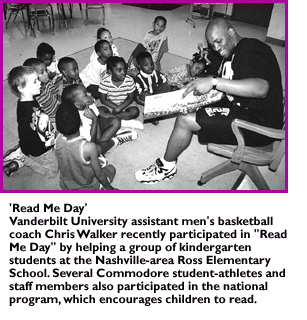The NCAA News - Briefly in the News
July 7, 1997
Georgia pools academic talent
Maybe it is something in the water.
 Four members of the Bulldogs men's and women's swimming teams were selected to receive NCAA postgraduate scholarships. Although the men's and women's swimming teams are separate, the selection of four athletes from one sport at a single institution for NCAA postgraduate scholarships is a notable and probably unique accomplishment.
Four members of the Bulldogs men's and women's swimming teams were selected to receive NCAA postgraduate scholarships. Although the men's and women's swimming teams are separate, the selection of four athletes from one sport at a single institution for NCAA postgraduate scholarships is a notable and probably unique accomplishment.
By definition, the scholarships go to academically gifted students. However, the Georgia bunch also has shown abundant athletics ability. All four have earned at least honorable mention all-America status and one -- Lisa Coole -- is a 19-time NCAA all-American and a two-time NCAA champion She plans to continue her studies in veterinary medicine.
Andy DeVooght was recognized earlier this year as winner of the H. Boyd McWhorter Southeastern Conference Scholar-Athlete Award, which includes a $10,000 postgraduate scholarship. He plans to enter law school.
Kelly Frazer earned all-America recognition in the 200 and 400 individual medley in 1996 while also being recognized as winner of Georgia's Lewis Leadership Award. Barry Wynn was an all-American in the 200 breaststroke while winning Georgia's Male Scholar-Athlete of the Year Award.
Bucking the odds
Who says that Jewish football players can't make it in the National Football League?
Freelance writer Edward Drossman reports that Alex Bernstein, a defensive tackle from Amherst College, has signed as a free agent with the Baltimore Ravens.
If he is able to stick, Bernstein would become one of only a few -- possibly one of only two -- Jewish players in the NFL.
Bernstein is familiar with Harris Barton, a lineman for the San Francisco 49ers. "I think Barton is listed as the only Jewish person in the league," he said. "Two years ago, a friend's father cut out an article from the Boston Globe that listed Barton as one of the largest Jewish men in the world at 6-5, 285 pounds. At this point, I'm 6-4, 330 pounds. I have 45 pounds on him. But Barton's been in the league for 15 years and I have yet to put on NFL pads."
Besides on-field success, Barton has served as a role model for Bernstein. "He's not breaking the law, flashing gold chains or he's not anti-social," he said. "He's certainly an inspiration. He's done a lot of charity work in the city of San Francisco and in synagogues."
Bernstein said he hopes he can follow Barton's steps and represent Jewish athletes with dignity.
A run on runs
Has any institution ever before supplied the top six statistical leaders in any category?
The women's softball team at Southern University, Baton Rouge, accomplished the feat this year with the top six individuals nationally in runs scored (see final statistics on page 11).
-- Compiled by David Pickle
-- Compiled by David Pickle
Looking back
5 years ago: A 21-member Special Committee to Review Financial Conditions in Intercollegiate Athletics is appointed jointly by NCAA President Judith M. Sweet and NCAA Presidents Commission Chair Gregory M. St. L. O'Brien. James E. Delany, commissioner of the Big Ten Conference, is named to chair the committee, which also includes 10 chief executive officers, two faculty athletics representatives and eight athletics administrators. The special committee is charged with studying virtually any issue that impacts on financial conditions in intercollegiate athletics, including issues related to financial control and integrity, financial aid, gender equity, compensation of athletics personnel, and the influence of athletics foundations, booster organizations and media revenues. (The NCAA News, July 8, 1992)
10 years ago: Data compiled from the first Division I Academic Reporting Forms submitted by member institutions indicates that student-athletes across the nation graduate at a rate roughly equivalent to, and possibly better than, the rate for all students. The 127 participating Division I institutions posted a median graduation rate of 66.6 percent, compared to 59 percent for all students. The data also reveal that Division I-A schools in the Northeast and Midwest make significantly less use of special admissions procedures for student-athletes than schools elsewhere, and freshman football and basketball players in those regions appear to post higher SAT scores. The data are the first obtained as a result of academic-reporting legislation adopted by the Association in 1985. (The NCAA News, July 8, 1987)
20 years ago: NCAA President J. Neils Thompson advises the membership that the Internal Revenue Service actively is considering imposing a tax on all revenues received by colleges and universities from the radio and television broadcasting of athletics contests, and possibly also athletics program advertising. The IRS raised the possibility that such funds may be regarded as "unrelated business income" during separate audits of three member institutions and the Cotton Bowl Athletic Association. Thompson warns that such a ruling probably would be applicable to all institutions. (NCAA News, July 15, 1977)
|